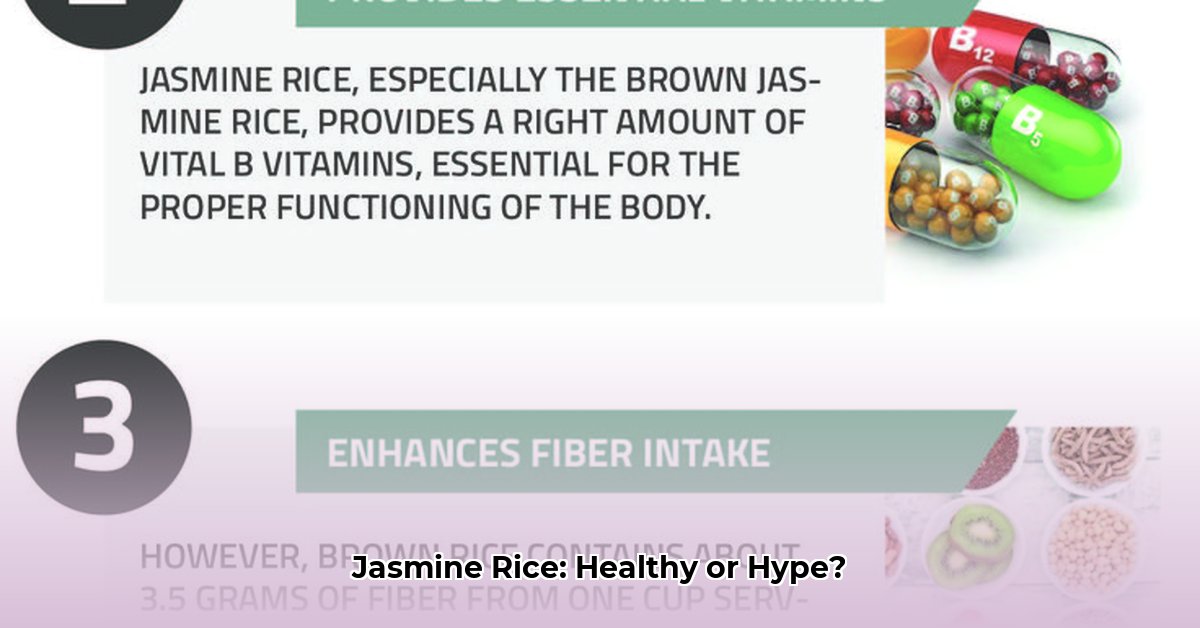Jasmine rice is known for its fragrant aroma and fluffy texture. But is it good for you? This article delves into the nutritional profile of jasmine rice, exploring its benefits, risks, and comparing it to other grains. We’ll cover everything from arsenic content to cooking methods, empowering you to make informed choices about incorporating this popular grain into your diet.
Decoding Jasmine Rice: A Nutritional Deep Dive
“Jasmine rice” isn’t a monolithic entity. Different varieties, primarily white and brown, offer distinct nutritional profiles. Understanding these differences is crucial for making healthy choices.
Brown jasmine rice, like other whole grains, retains its bran and germ layers. These layers are rich in fiber, B vitamins, and minerals like magnesium and manganese. White jasmine rice, however, has these layers removed during processing, resulting in a different texture, taste, and nutritional composition.
Here’s a comparison of white and brown jasmine rice:
| Nutrient | White Jasmine Rice (1 cup cooked) | Brown Jasmine Rice (1 cup cooked) |
|---|---|---|
| Calories | ~205 | ~218 |
| Total Fat | ~0.4g | ~1.8g |
| Carbohydrates | ~45g | ~46g |
| Fiber | ~<1g | ~3.5g |
| Protein | ~4g | ~5g |
The significant difference in fiber content is noteworthy. Fiber is crucial for digestive health and may help manage cholesterol levels. Brown rice also typically contains higher amounts of iron and magnesium. White rice, while lower in these nutrients, is often easier to digest, which can be beneficial for some individuals.
Glycemic Index and Blood Sugar Impact
The glycemic index (GI) measures how quickly a food raises blood sugar. White jasmine rice has a higher GI (70-80) than brown jasmine rice (50-60). This means white rice can cause more rapid blood sugar spikes, a potential concern for those with diabetes. The fiber in brown rice helps slow down sugar release, leading to a more gradual rise.
Several factors, including cooking methods, can influence the GI of rice. Some studies suggest that parboiling (partially boiling before milling) may lower the GI. Cooling cooked rice and then reheating it increases resistant starch, which digests more slowly and has a gentler impact on blood sugar.
Arsenic in Rice: Addressing Concerns
Rice absorbs arsenic from the environment more readily than other crops. While this is a valid concern, rinsing rice thoroughly before cooking can significantly reduce arsenic levels. Varying your grain intake throughout the week, including options like quinoa, millet, and bulgur, is also recommended.
Jasmine Rice and Weight Management
Jasmine rice can be part of a healthy diet for weight management. Portion control and balancing it with other nutritious foods are key. The fiber in brown jasmine rice promotes satiety, potentially reducing overeating.
Beyond White and Brown: Exploring Colored Varieties
Black and red jasmine rice, though less common, offer unique nutritional benefits. They often contain antioxidants, specifically anthocyanins, which are associated with various health benefits.
Comparing Jasmine Rice to Other Grains
Here’s how jasmine rice stacks up against other popular grains:
| Grain/Rice | Calories (1 cup cooked) | Fiber (g) | Approximate Glycemic Index |
|---|---|---|---|
| White Jasmine Rice | ~200 | <1 | 70-80 |
| Brown Jasmine Rice | ~215 | ~3 | 60-70 |
| White Rice | ~205 | <1 | 70-80 |
| Brown Rice | ~215 | ~3 | 50-60 |
| Basmati Rice | ~210 | <1 | 50-60 |
| Quinoa | ~220 | ~5 | ~53 |
| Millet | ~207 | ~2 | ~71 |
| Bulgur | ~151 | ~8 | ~48 |
This table provides a general comparison. Remember that these values can vary based on specific variety and cooking methods.
The Bottom Line: Making Informed Choices
Is jasmine rice healthy? Consumed in moderation and as part of a balanced diet, yes. Brown jasmine rice is generally preferred due to its higher fiber and nutrient content. Rinsing rice before cooking and varying your grain intake are important considerations.
For personalized dietary advice, consult a healthcare professional or registered dietitian. Our understanding of nutrition is constantly evolving, so staying informed about the latest research is always beneficial.
- Bento Box Trays Streamline Restaurant Meal Presentation and Transport - December 13, 2025
- Plastic Bento Boxes Face Scrutiny Over Sustainability Impacts - December 11, 2025
- Bento Tray Revolutionizes Organized Meal Transport and Presentation - December 10, 2025










